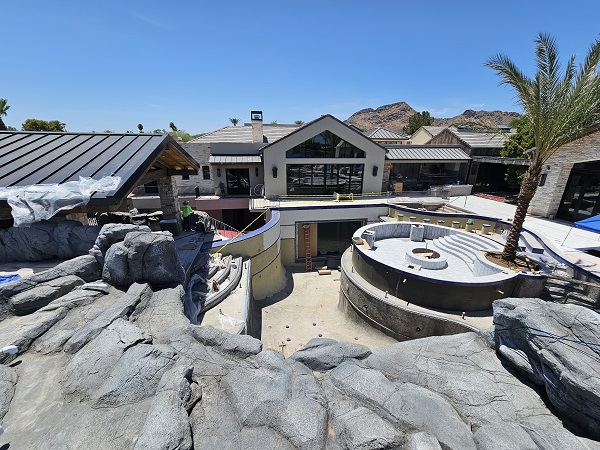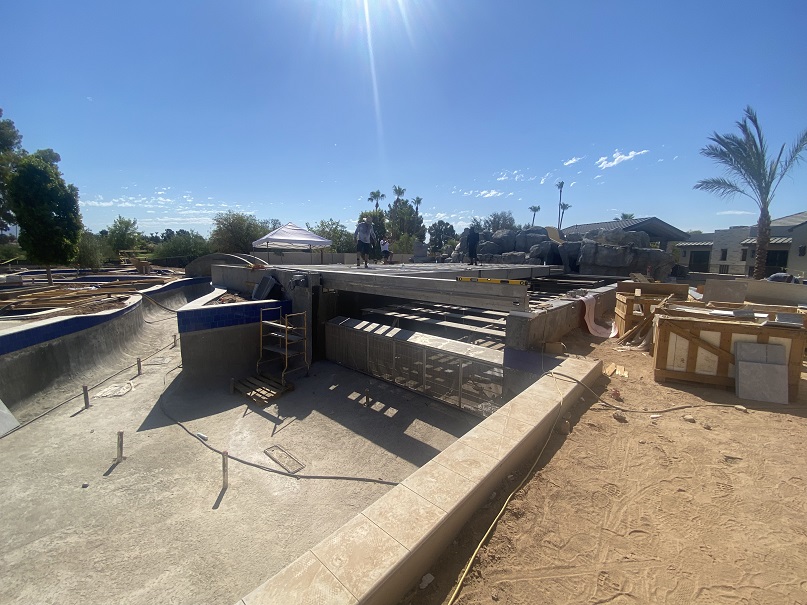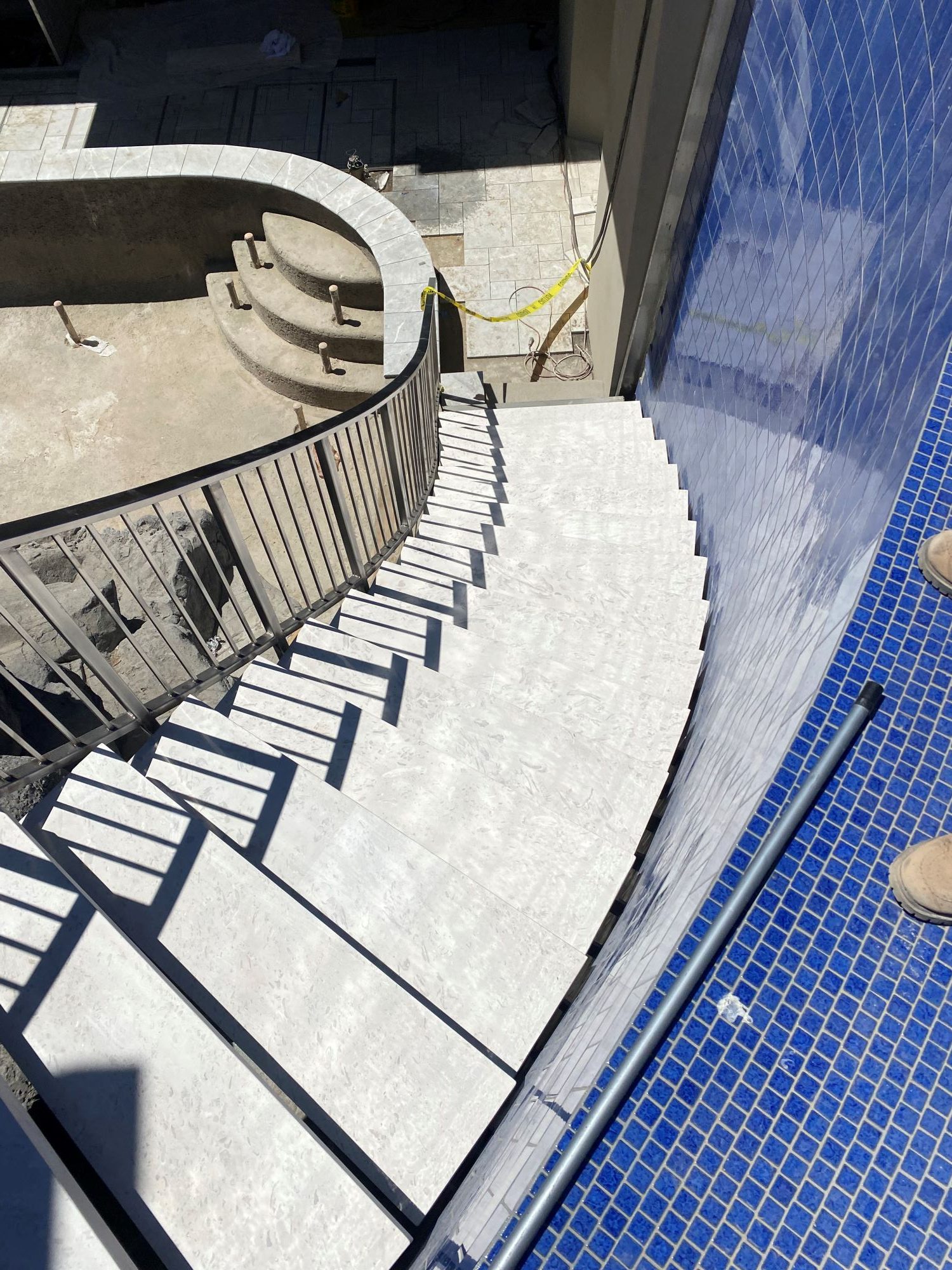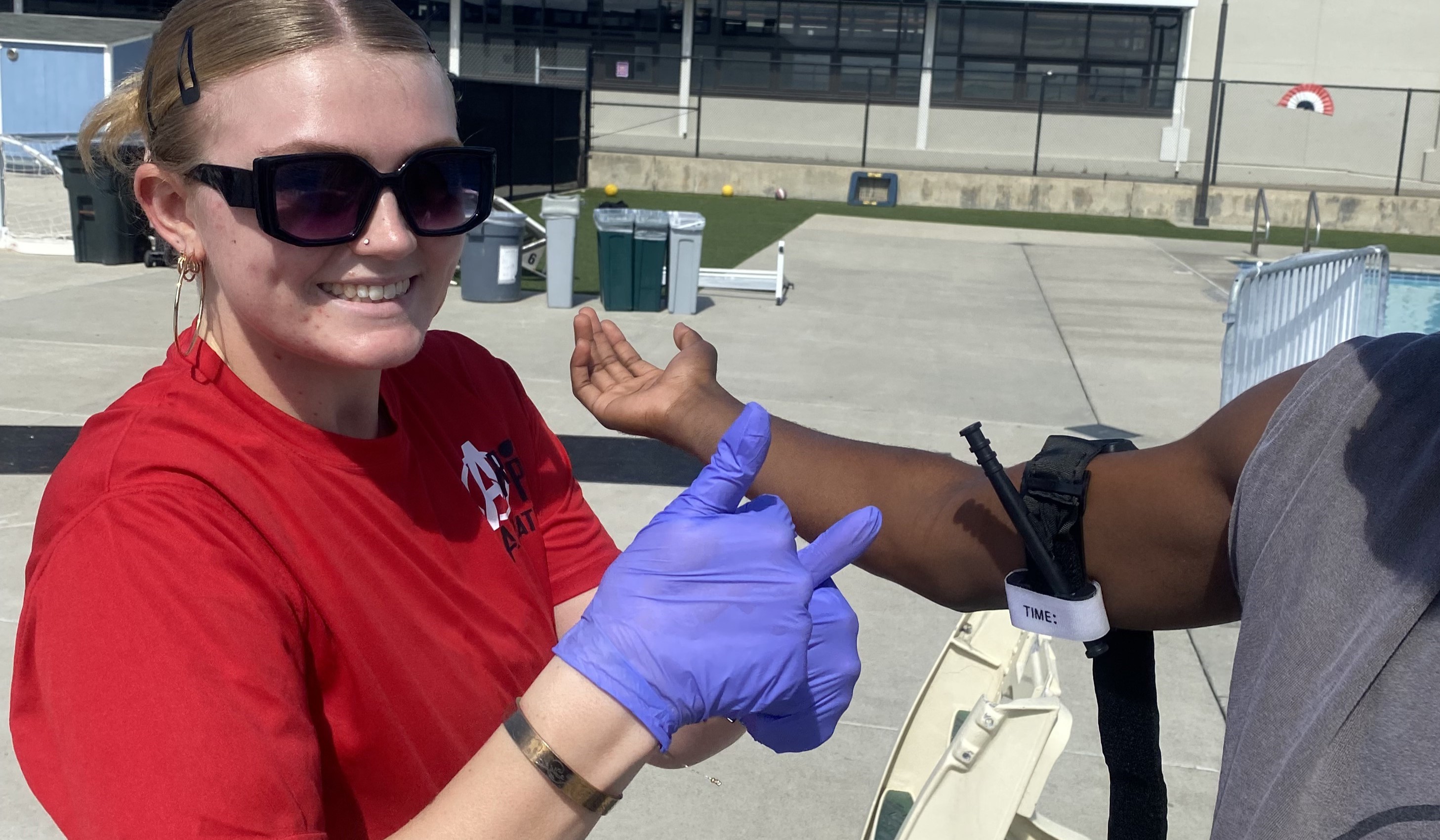With almost three years behind us, we’re on the home stretch to finishing this backyard waterpark — perhaps the largest we’ve ever designed and installed.
Photo: Red Rock Pools & Spas
The main pool reaches 17-foot depths. The area with the palm tre…
The site includes a large main outdoor pool, two-level grotto with a deck above it, a secondary outdoor pool set at basement level, and an indoor pool.
But most unique are the amusement-park-level features: a 550-foot-long lazy river with acrylic windows in the floor that peer into a go-kart track below; a shark tank, with windows on both sides to be viewed from the home and pool; and the custom-fabricated surf simulator with a movable deck that covers the machinations in the absence of hang-10s.
Over the last few months, we’ve made major strides on the latter, especially. And with so much of the large structural work complete, we’re now focusing on the extremities of the entire project, including pump and equipment set-up, applying finishing materials, and installing final touches such as handrails and landscaping.
Surf Simulator and Movable Deck
The surf simulator, custom designed by FlowRider, is inflatable so that, when not in use, it will be deflated, stowed in the basin below and then covered by a movable deck.
The movable deck, by Twinscapes, will sit on a bed of artificial turf when the surf machine is in use. It will be finished in a composite material.
Below the surf simulator and movable deck sits a walk-in vault space holding all the mechanical and operational systems for these two features. With so much of the rest of the site built up, access was limited, which required us to crane this equipment in place. This required quite a bit of coordination and planning.

The surf simulator in progress. The inflatable portion will sit atop the slats, with the funnel intake underneath. The notches in the edges of the basin will accommodate rollers for the movable floor.
The vault is in place, and now the FlowRider and movable deck are being built concurrently, because they’re so closely connected.
Installing the inflatable portion of the Flow Rider is one of the last things we will begin and one of the last that we finish. We’re holding off on this portion until 99% of the job is complete, so the inflatable component doesn’t get damaged from surrounding construction.
The surf simulator measures 43 feet long and 16 feet wide, or almost 700 square feet. It consists of a substructure that starts with a cast-in-place basin. Inside the basin, about 48 inches above the floor sit a series of horizontal slats, which will support the inflatable. Underneath the slats sits a large funnel intake that goes to a 125 horsepower motor that then curves the water back and sends it across the top of the surf machine.
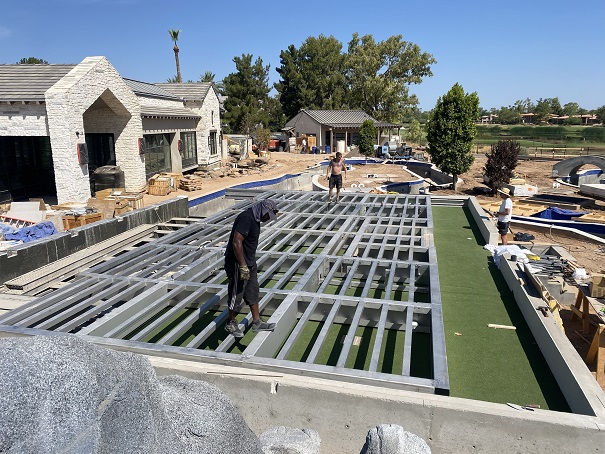
The movable floor during installation, with the artificial turf pad below.
Of all the things that set this system apart from a construction standpoint, probably the most unusual was the power requirement. It is driven by a 125 horsepower, three-phase pump — 121/2 times the size of even a pump that we’d use for your typical lazy river, and 50 times bigger than a typical pool pump, when it comes to voltage and load.
The moving deck has required some of the most delicate construction on this project. We have to build it to zero tolerances — that 50-by-50-foot area has to be literally perfect. The movable deck was built in Twinscapes’ headquarters in Spain. It came in eight modules that we have attached in the field to create the deck. This is one of the largest decks they have built to move horizontally.
Then we had the FlowRider getting built in another part of the U.S. — and their normal tolerances are tiny in any application. When we brought the deck and surf simulator together on site, we had to match all dimensions perfectly. We have had to double, triple and quadruple-check everything with the four project managers we have on site everyday. Then the manufacturers could come in and assemble everything in place. For them, it’s like a big erector set.
On one side of the surf simulator basin are notches in the concrete. These accommodate the rollers for the moving deck. Because this was a one-off installation, the system required some adjustments in the field, as well as in the factory. The system rolls on very wide nylon wheels, which we hoped could run directly across the artificial turf pad underneath. But we discovered two things. First, the turf provides more resistance than we wanted. But also, because of the Phoenix heat, the nylon rollers were crushing the turf during testing. We’d expected to see a wear pattern over time, but just during testing, the turf became damaged enough to be obvious. So we’re going to use different wheels and install a stainless steel track for them, rather than having them roll directly on the turf. This way, we expect everything to stay aligned. We’ll cut the turf out of the wheel areas, set an alignment track in place, then change to rollers that have guides on them so they’ll remain on the track. This should lower the resistance and keep it tracking better.
We expect the same kind of fine-tuning with the FlowRider. Once we complete it, we’ll start running it to make sure we get the kind of flow we want, in terms of volume and direction. We used vector analysis during the design phase to predict how it would move and affect the lazy river. But, once we get it fired up, we’ll see how the surf simulator works and fine-tune the variable-frequency drives to speed it up or slow it down as needed. We also might have to adjust where the water is coming from (front or back) to make sure everything functions as intended.
Equipment sets and vaults

One of several outdoor equipment sets.
We have multiple outdoor equipment yards and underground equipment vaults to optimally manage the efficiency of the various systems. Instead of having everything in one place and running the plumbing miles away, we have three outdoor pool filter and pump areas, plus seven underground vault systems throughout the property. In addition to the equipment you’d see in any pad, some vaults also contain the river pumps or in-floor cleaning valve actuators. This keeps things closer to where we’re using them, instead of trying to transgress the entire property.

One of the indoor equipment vaults; artificial rockwork on one of the grottos.
We’ve overloaded the automation systems offered by anyone when it comes to pumps, valves or triggers. To handle it all, we have three separate equipment automation systems that can work autonomously or within the home-control system. Each operates as a stand-alone system and has its own login.
Grottos and Rockwork
The artificial rockwork throughout the project is more than 95% complete.
Some areas still need final touchup and paint, but the rock structures are now built and in place. It’s just some minor tweaking, touch-up and paint areas.

A grotto under construction, with the swim-up spa in the foreground.
This includes the two-level grotto with deck on top. This will include a full bar with plenty of appliances, so we’re using residential house plumbers to handle the drain lines and plumbing fixtures. We’re finishing with the spas and swim-up bar areas, and starting to get the cabinets and finishes in place.
At this point, we’ll start work on the deck above the grottos, where we’ll have a fire pit, seating area and stairs.
Our rock crew has been working on this job for seven months straight — all day, everyday. This time, we used faux rock because we had no access to set up cranes and move boulders around. When you get to this scale, the rocks have to be the size of cars, so guys cannot move them without the machinery. Plus, real rock probably would have cost double. Real stone just takes a lot more to manage, cost-wise and time-wise. Faux rock also provides increased design flexibility.
Preparing to finish
As I’ve mentioned before, the design of this project has taken hundreds of hours. Given the scale, commissioning also will take several times longer than it would on a typical backyard.
We made sure to inform the homeowner early on that we expect 45 days to get through commissioning and operations — making sure everything not only operates but works as intended.
We currently have the shark tank going through this stage — we’re starting to put the water in and get it ready for life.
Every phase of this pool will involve the same process — from slides to waterfalls to mist systems to the Flow Rider to movable decks to river current systems to go-kart charging and tracks. We expect to do that whole process with a crew of three or four people.

